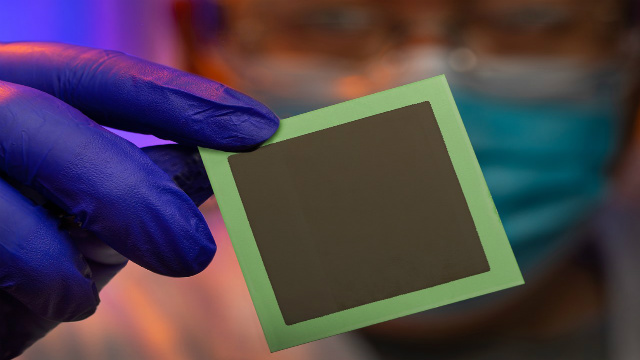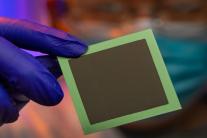Aircraft fuel cell development takes flight after UL Lafayette lands grant
Wed, 12/16/2020 - 3:45pmAn energy storage and power generation system being designed at the University of Louisiana at Lafayette could make flying the friendly skies less harmful to the environment.
Solid oxide fuel cells are “a key component” within that system, said Dr. Xiao-Dong Zhou. Their inclusion in the next generation of electric aircraft could cut carbon emissions – and that’s caught the eye of the U.S. Department of Energy, which awarded UL Lafayette a $2.26 million grant this fall.
Commercial aviation accounts for about 2.6% of greenhouse gas emissions, but as air travel increases, so does this environmental impact. Greenhouse gases such as carbon dioxide are a primary culprit in global climate change.
Zhou believes solid oxide fuel cells could check the growing environmental threat. He is executive director of the Institute for Materials Research and Innovation and holds the Stuller Endowed Chair in Chemical Engineering in UL Lafayette’s College of Engineering.
Solid oxide fuel cells are electrochemical devices that generate cost-effective electricity and, depending on the type of fuel that’s used, emit no or lower amounts of pollutants such as carbon dioxide. They convert chemical energy into electrical energy from a variety of fuels at an efficiency as high as 70 percent, Zhou said. By comparison, the thermal efficiency of a gasoline engine is about 30 percent.
Propulsion systems used by commercial aircraft “produce a substantial amount of carbon dioxide,” Zhou said. But, if they included a hybrid energy storage and generation system that combined solid oxide fuel cells, a small turbine powered by biofuels, and batteries, aircraft “would be more efficient and more environmentally friendly.”
“The overall scope of the research is to create an energy storage and power generation system for electrical aviation. Solid oxide fuel cells are key within that system.”
Zhou and the Institute for Materials Research and Innovation have extensive experience in the creation of highly efficient solid oxide fuel cells. But including them as part of an aircraft storage and power generation system required an “airplane guy.”
That’s how Dr. David Daggett described himself. The former technical fellow for aerospace giant Boeing has partnered with Zhou and his team of UL Lafayette researchers on the project’s second step – ensuring that the fuel cells produce power that’s sufficient for the plane’s needs at varying stages of air travel.
“We need to know how it behaves over the whole flight cycle,” Daggett said, including taxiing, taking off, cruising and landing. That means examining how many fuel cells are needed at any given time. Each cell produces only a small amount of power, so they have to be combined into “stacks” to generate more. That can be a hefty proposition when trying to get an airplane off the ground.
“That’s all our study is about in the first phase: how do we optimize the fuel cell to make it as light as possible? Then how do we put it into the airplane to power the whole airplane? And we don’t know yet if it is going to fit. Weight-wise, we know it’s going to work, but can it fit? We'll see.”
While at Boeing, Daggett studied including fuel cells in an airplane auxiliary power unit, but engineers found their weight was too heavy. That was 15 years ago.
“But we said, eventually this technology is going to mature. And when it does, then it’s going to make its way onto the airplane. And we’re finally to a point now where the weight has reduced and the technology has matured.”
Dr. Subhash C. Singhal agreed. Like Daggett, he is working with UL Lafayette on the project. He’s the former director of fuel cells at Pacific Northwest National Laboratory in Washington state and has studied solid oxide fuel cells for more than a half century.
Singhal said the project’s aim to include solid oxide fuel cells within an aircraft power storage and generation system is “the next step in the application of this technology.”
“Weight is not a consideration for stationary power plants, but for aircraft we need to worry about the weight,” he said. That’s why the solid oxide fuel cells being developed by Zhou and his team at UL Lafayette are “just perfect for this application. They will lower the weight, lower the cost and increase the efficiency.”
And, if commercialized, they’ll reduce carbon emissions in the next generation of aircraft, Daggett added. “Currently, commercial aviation accounts for something like 2.6% of carbon emissions. It’s not a huge part, but more attention is being paid to it, and the airlines are concerned about that. It’s contributing to global warming, and this is a solution.”
In addition to Daggett and Singhal, UL Lafayette’s team consists of Dr. Rafael Hernandez, head of the Department of Chemical Engineering, and Dr. Jonathan Raush, assistant professor of mechanical engineering.
Idaho National Laboratory and Nexceris, an Ohio-based company that focuses on solid oxide fuel cell and stack fabrication technology, are partnering with the University on the project.
The $2.26 million grant UL Lafayette received is part of a $18.5 million round of funding from the Department of Energy’s Range Extenders for Electric Aviation with Low Carbon and High Efficiency, or REEACH, program. Altogether, eight projects received REEACH funds.
A companion initiative, the Aviation-class Synergistically Cooled Electric-motors with iNtegrated Drives, or ASCEND, program, awarded $14.5 million for nine projects.
The Department of Energy’s Advanced Research Project Agency-Energy oversees the REEACH and ASCEND programs. Both initiatives aim to decrease energy usage and associated carbon emissions for commercial aircraft propulsion systems.
Photo caption: UL Lafayette’s Institute for Materials Research and Innovation is testing solid oxide fuel cells such as the one shown here that could become key components in an energy storage and power generation system for commercial aircraft. (Photo credit: Doug Dugas / University of Louisiana at Lafayette)


